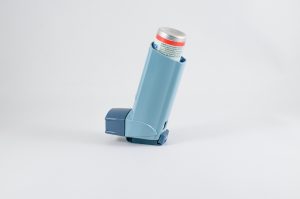
According to the World Health Organization, 235 million people suffer from asthma worldwide.1 Chronic obstructive pulmonary disease (COPD) sufferers number 251 million, with 65 million having a moderate to severe form of this respiratory condition. Globally, deaths caused by these diseases numbered 383,000 and 3.17 million, respectively.
Inhaled medication, administered via an inhaler, is one common treatment. Inhalers have been used since the late 1700s, but the pressurized metered-dose inhalers that patients use today weren’t invented until 1955, by American doctor George Maison. Maison’s invention allowed the prescribed dose of asthma medication to be expelled into the lungs by pushing a button. These inhalers were meant to be an improvement over nebulizers which some patients found difficult to use and as a result failed to get the proper dose of medicine.
Despite metered-dose inhalers being an improvement from earlier methods of medication delivery, studies have shown that patients who use them make at least one mistake while taking their medication in this manner 70-90% of the time, resulting in only 7-40% of the medication reaching their lungs. The two most common mistakes include a delay between inhalation and administering the dose of medication and not breathing deeply enough.
An improvement over these traditional inhalers may be smart inhalers. Smart inhalers have either built-in sensors or clip-on sensors that turn a traditional inhaler into a smart inhaler. The sensors are used to track the medication, dosage and time taken for each dose. Some have monitors for inspiratory flow rate. These sensors link with an app on a smartphone or tablet, with the data saved to the cloud so that doctors and caregivers can access the data. Doctors can monitor whether patients are taking their medication as prescribed and if they are using their inhaler correctly. The app can also provide reminders to patients when they need to take another dose. All of these innovations are meant to help patients get the proper dose of medication on a more consistent basis so that the use of a rescue inhaler is minimized and their quality of life improves. There are also clip-on sensors for rescue inhalers that monitor usage and send notifications when the users leave their inhalers behind. The data gathered can also be used to determine what triggers their asthma attacks.
Today’s market size shows the global revenue for smart inhalers in 2018 and projected for 2026. The North American market generated the highest revenue in 2018 while the Asia-Pacific region is expected to experience the highest growth over this period. Some leading companies in this industry include Propeller Health; Adherium Ltd.; Teva Pharmaceutical Industries Ltd.; AstraZeneca, PLC and GlaxoSmithKline, PLC.
1 According to the Global Asthma Network’s report The Global Asthma Report 2018, 339 million people worldwide suffer from asthma.Geographic reference: World
Year: 2018 and 2026
Market size: $34 million and $1.4 billion, respectively
Sources: “The Global Smart Inhalers Market Size Was Valued at $34 Million in 2018 and Is Estimated to Reach $1,406 Million by 2026, Growing at a CAGR of 58.4% from 2019 to 2026,” CISION PR Newswire, August 7, 2019 available online here; “Asthma,” World Health Organization, August 31, 2017 available online here; “Chronic Obstructive Pulmonary Disease (COPD),” World Health Organization, December 1, 2017 available online here; “Chronic Respiratory Diseases: Burden of COPD,” World Health Organization available online here; “Inhalers,” Brought to Life: Exploring the History of Medicine available online here; Laura Lovett, “Teva Pharmaceutical’s AirDuo Digihaler Gets FDA Green Light,” MobiHealthNews, July 15, 2019 available online here; Dr. Andreas Alt, “Flow Measurement in Smart Inhalers for Connected Drug Delivery,” Medical Product Outsourcing, March 1, 2019 available online here; The Global Asthma Report 2018, Global Asthma Network, 2018 available online here; “Smart Inhalers,” Asthma UK available online here; “Control Your Asthma with FindAir Smart Inhaler,” FindAir, 2018 available online here.
Image source: Bob Williams, “inhaler-breath-asthma-breathing-2520471,” PIxabay, July 19, 2017 available online here. Picture shows a traditional inhaler, not a smart inhaler.
